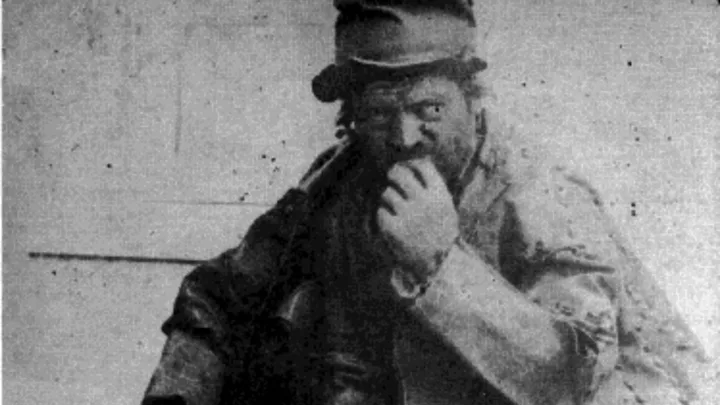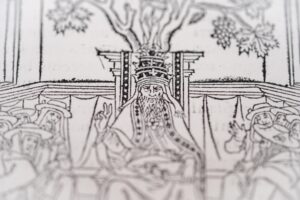The Leatherman was a man of few words. He roamed from town to town in the mid-1800s, in a continuous circuit from the Connecticut River to the Hudson, carrying nothing but a backpack and an incredible stock of tobacco. Haggard-looking and clad entirely in leather, the Leatherman was an enigma.
A vagabond existence
Some sources suggest the Leatherman started to roam Connecticut in 1857, just before the American Civil War. At the time, itinerant vagabonds were not uncommon. They passed through towns, begging for money or food. But the Leatherman was different.
The Leatherman traveled a 580km loop in roughly 34 days, before starting again. He followed this route for 30 years, accumulating over 160,000km.
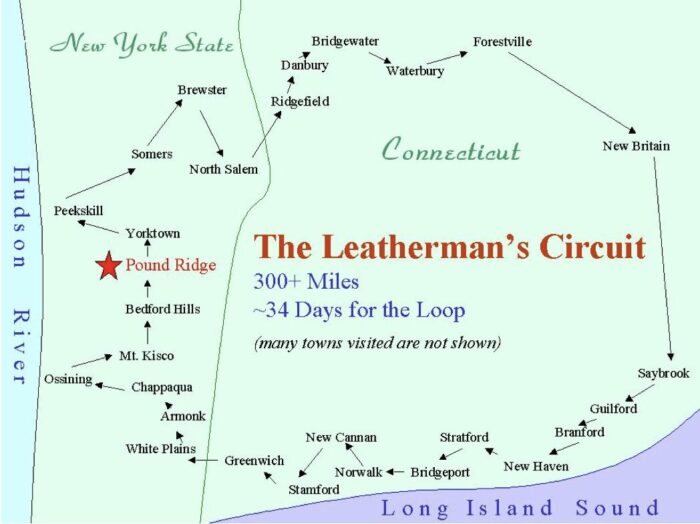
A map of the Leatherman’s route. Photo: Connecticut Yankee Council
Locals described him as punctual because they could predict the day and time of his arrival, often within half an hour. Schoolhouses would have a Leatherman Day, in which teachers selected students to present the Leatherman with gifts and food as he passed. Though the Leatherman never conversed with the curious residents (he only grunted, gestured, or spoke a few monosyllabic words in English or some French), the towns along the circuit grew fond of him. He was peaceful, despite his intimidating appearance.
His most distinctive feature was his eccentric fashion. Everything from his hat to his shoes was made of leather patches; the outfit weighed 27kg.
“His coat was made of pieces of leather, each about eight by 10 inches, stitched together with thongs similar to heavy boat laces,” The New York Times wrote. “His trousers were made of the same types of patches, as was his hat.”
Adopted by communities
Communities pitched in to make sure the Leatherman was fed. However, when they tried to give him medical care or money, he refused. Yet somehow, he always had funds to purchase small items such as tobacco (of which he was very fond), sardines, bread, coffee, brandy, and pie. He carried his supplies to makeshift homes deep in the woods. These were often caves or stone shelters that he built. He stayed warm in extreme weather and kept his dwelling space orderly.
The Leatherman was so beloved that he was exempted from persecution under the Connecticut Tramp Law of 1879, which criminalized vagrants.
A correspondent with the Port Chester Journal, Jonathan Tillotson, wrote about the Leatherman in 1870. Tillotson says he was a Frenchman in his mid-30s and lived in the woods under a rock shelter, with a well for water and a garden for growing food. However, the soil was poor, and he often went into town for a decent meal.
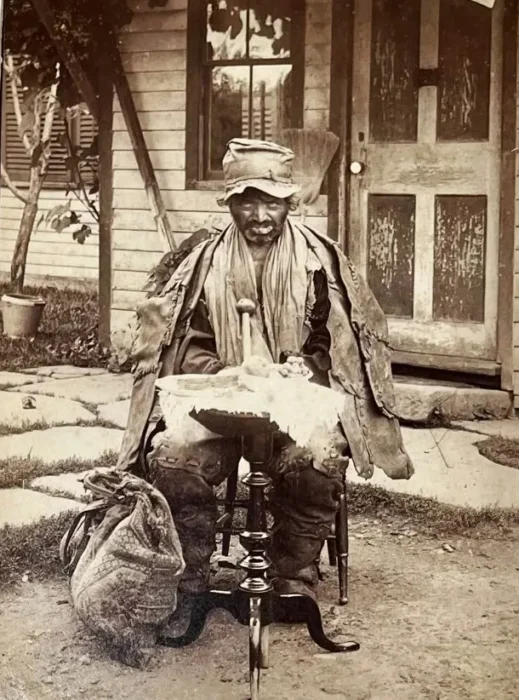
Despite the glower, the Leatherman was a much-beloved character. Photo: Easton Courier
Theories
Although the Leatherman became familiar to those along his route, no one knew anything about his background, history, or personal life.
Those who managed short conversations with him found that he responded more to French than English, leading them to believe he came from France. There was a rumor that the Leatherman had revealed to a reporter that his real name was Rudolph Mossey. Born in the town of Rouen, he was a married shoemaker. When his wife ran off to America with another man, Mossey followed, hoping to find the man who stole her.
But by the time he arrived, he found out that she had been traveling around the countryside and sleeping with men before eventually passing away from an unknown cause. Mossey was heartbroken and proceeded to travel to all the towns his wife visited in remembrance of her. However, after a local paper published this story, they soon retracted it.
The Waterbury Daily American, a local newspaper, claimed the Leatherman’s real name was Jules Bourglay. Bourglay was a woodcutter from France who fell in love with the daughter of a leather merchant. To prove himself, Bourglay convinced her wealthy father to let him work in the leather factory. Things were going well until the value of leather declined, and the merchant lost his business. The merchant’s daughter would never marry Bourglay, leading to a deep depression and his life as a vagabond.
James F. Rodgers snapped a rare photo of the Leatherman. After getting him comfortable enough for some questions, Rodgers asked for his name. “It is E-zek,” the Leatherman said.
During their conversation, the Leatherman stated that he was from France, never wanted to go back, and was 68 years old. He was a Roman Catholic who carried a French prayer book and rosary. It is possible that “E-zek” was his French pronunciation of the name Isaac.
His death and burial
In 1888, the Leatherman’s health declined rapidly. He had survived one of the most severe blizzards in American history, but had bad frostbite on his nose and some fingers, and a growth inside his throat and on his lips. He refused medical treatment, and eventually the authorities had to “arrest” him to save his life.
The Waterbury Daily American reported on attempts to treat him:
He was apprehended at the instance of the Connecticut Humane Society and taken to a hospital in Hartford, where it was hoped something authentic concerning the life and history of the mysterious, eccentric pedestrian might be learned. The old fellow has been failing rapidly since his exposure in the blizzard of last March, but his wandering, restless spirit has not been curbed, for two nights ago, he escaped from the hospital and resumed the lonely circuitous tour of wandering in Connecticut and Eastern New York which he has followed for the past 25 years by night and by day.
Not long after, a couple was taking a stroll in the Saw Mill Woods and happened upon the Leatherman’s cave. There, they found him lying face down, his face bloated. The Leatherman was dead.
After examining him, doctors concluded that “The immediate cause of his death is blood poisoning. It resulted from lupus, which had made frightful ravages in his mouth, almost destroying the lower jaw.”
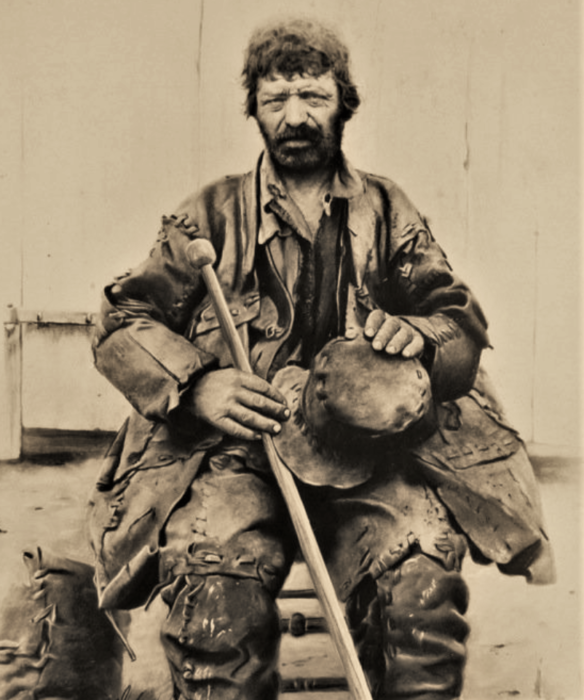
The Leatherman in his patchwork leather suit. Photo: Easton Courier
The Leatherman was buried in an unmarked grave in Ossining, New York’s Sparta Cemetery. Eventually, in the 1950s, an official headstone with the name Jules Bourglay was placed there.
In 2011, despite local opposition, a group of researchers decided to exhume the Leatherman’s body and test his DNA to find out more about him. However, when they exhumed the grave, they found that the body was missing. All that remained were some rusty nails. They reburied the nails with a headstone bearing the inscription, “The Leatherman.”
What happened to the body?
One can speculate that locals who opposed the exhumation might have stolen the body, but there is no evidence of this. Researchers believe that vibrations from a nearby road may have disintegrated the body or that the grave marker was not placed in the correct location.
Shortly after his death, the Globe Dime Museum, attempting to compete with popular freak shows, bought the Leatherman’s leather suit and paid an actor to wear it. They promoted him as the original Leatherman and claimed he was 200 years old.
